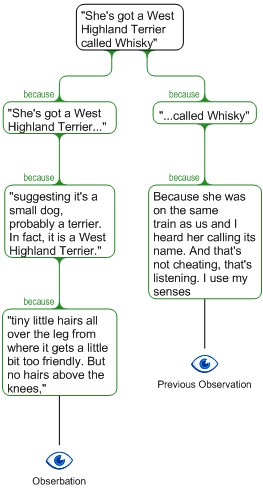 In my last post, I wrote about how to reverse engineer Sherlock Holmes deductions. I'm interested in learning how to create these deductions in my current computer game research project and also some future fiction that I'm working on.
In my last post, I wrote about how to reverse engineer Sherlock Holmes deductions. I'm interested in learning how to create these deductions in my current computer game research project and also some future fiction that I'm working on.Like in my last post, let's continue working with a deductions from the new series "Sherlock
See the video clips and then the transcript and analysis below.
(If these video clips are no longer available full video on the PBS site (39:00-40:40).)
The Widow and the Fisherman Deduction (Part 1 of 2)
The Widow and the Fisherman Deduction (Part 2 of 2)
Text of the deduction:
SHERLOCK: There is nothing wrong with me! Do you understand? You want me to prove it, yes?
We're looking for a dog, yes? That's your brilliant theory. Cherchez le chien! Good, excellent, yes, where shall we start? How about them? The sentimental widow and her son, the unemployed fisherman. The answer's yes.
WATSON: Yes?
SHERLOCK: She's got a West Highland Terrier called Whisky, not exactly what we're looking for.
WATSON: Sherlock, for God's sake.
SHERLOCK: Look at the jumper he's wearing, hardly worn. Clearly he's uncomfortable in it. Maybe it's because of the material, or more likely the hideous pattern, suggesting it's a present, probably Christmas. So he wants into his mother's good books. Why? Almost certainly money. He's treating her to a meal but his own portion small. That means he wants to impress her, but he's trying to economize on his own food. WATSON: Maybe he's just not hungry.
SHERLOCK: No, small plate, starter. He's practically licked it clean. She's nearly finished her pavlova. If she'd treated him, he'd have had as much as he wanted. [first video clip ends] He's hungry all right, and not well-off, you can tell that by the state of his cuffs and shoes. [second video clip begins]
SHERLOCK (continues): "How do you know she's his mother?" Who else would give him a Christmas present like that? Well, it could be an aunt or older sister, but mother's more likely. Now he was a fisherman, the scarring pattern on his hands very distinctive, fish hooks. They're all quite old now, which suggests he's been unemployed for some time. Not much industry in this part of the world, so he's turned to his widowed mother for help. "Widowed?" Yes, obviously. She's got a man's wedding ring on a chain around her neck, clearly her late husband's and too big for her finger. She's well dressed, but her jewelry is cheap. She could afford better, but she's kept it-- sentimental.
SHERLOCK (continues): Now the dog-- tiny little hairs all over the leg from where it gets a little bit too friendly. But no hairs above the knees, suggesting it's a small dog, probably a terrier. In fact, it is a West Highland Terrier called Whisky. "How the hell do you know that, Sherlock?" Because she was on the same
train as us and I heard her calling its name. And that's not cheating, that's listening. I use my senses, John, unlike some people, so, you see, I am fine.
---------
In this set of deductions there are five claims.
- The woman is a "sentimental widow."
- The jumper/sweater is a present from his mother.
- The man is trying to get money from his mother.
- The man is a fisherman who has been employed for some time.
- The woman has a West Highland Terrier called Whisky.
Claim 1:
In this deduction there is a new basis in the reasoning. Holmes basis comment about the jewelry on some expert knowledge. We did not see this in the previous analysis.
Claim 2:
With this deduction there are some unstated assertions. How to work those into a computer game? Also new: there is an objection (in red).
Claim 3:
Here: A reason based on logic and unstated widely held belief.
Claim 4:
This deduction is the most complex so far. Not new: Observation and widely held belief. New: An objection (in red) and then a counter to the objection (in yellow).
Claim 5:
In this deduction, there is observation as before. What's new, though? The observation regarding the name of the dog does not happen at the time of the deduction. A player in a computer game would then need to be able to recall previous observations/examinations.
So far, based on the above analysis and the previous analysis, it seems that a computer game which allows the player to use the Holmes method would need to be able to do the following.
- Allow the play to observe. Observe or examine is a common ability given in computer games, so that would not be difficult. An observe/examine action would result in the player getting information about the object, person, etc."
- Allow the player to recall/know.
- General knowledge
- Facts - train schedules, size of dogs, etc.
- Commonly held beliefs
- Expert knowledge
- Value of jewelry
- Other?
To be continued.
Share this post with others. See the Twitter, Facebook and other buttons below.
Please follow, add, friend or subscribe to help support this blog.
See more about me at my web site WilliamHartPhD.com.





No comments:
Post a Comment
Thank you for your comment.
Your comment will be reviewed.
If acceptable, it will be posted after it is carefully reviewed. The review process may take a few minutes or maybe a day or two.